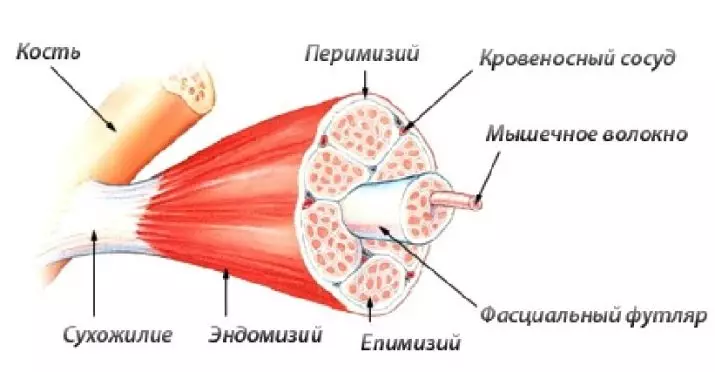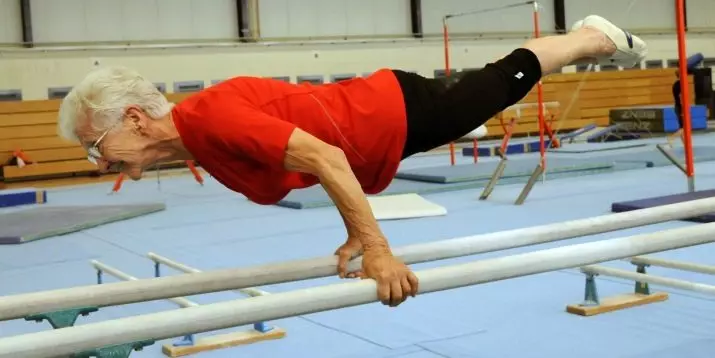The body's ability to respond to physical exertion after a long pause and to achieve the former results is explained by the work of muscle memory.
What it is?
Muscular memory develops due to physical activity and ensures the restoration of the muscular mass after long idle. The human body is able to memorize the level of tone of muscles that occurred in the nerve cells and the structure of muscle fibers. In the body there are long-term changes, information about which fall into the engine's motor cortex of the human brain. All information on the number of muscle contractions and about any other physical activity is preserved in brain structures. Physical actions brought to automatism fall into memory storage.
The formation of such a memorization occurs at an unconscious level. The main purpose of muscle memory is the resumption of workouts after the forced interruption and use at its own discretion. This process provides athlete the rapid restoration of the sports form after a long pause associated with the disease, trauma, travel, the birth of a child, or as a result of another circumstance. People who are engaged in sports are more quickly restored after a heart attack, stroke and other heavy diseases.
Besides, well-developed muscle memory facilitates risk reduction.
A convincing example is the ability to ride a two-wheeled bike. Man, while still a child, learned to keep the balance while riding in this form of transport, does not lose the skill never. Actions and movements are reproduced automatically through a large number of years.

Mechanism of functioning
Muscular memory runs through the interaction of muscles and the brain, the binding component of which is the nervous system. During the fulfillment of physical exercises, the brain estimates their level and decides which organs and parts of the body should be used. Muscle pulses are sent through the nerve fibers capable of producing the necessary actions to achieve the desired result. Information is fixed in muscle fibers. If you need to perform this exercise in the future, the muscles are ready for its implementation.
This type of memory is closely associated with muscle fibers of a certain size. They constitute a merger of several cells that combine cytoplasm. Muscular fiber is inherent in a multi-core system. Satellite cells are capable of dividing to increase the number of cores, each of which is surrounded by ribosomes. It is in them a protein synthesis. These processes lead to an increase in muscle fiber, which can exceed a single-core cell in size 5 times. In the untrained fibers, the cores are not enough, so they have small parameters.
During the heavy training, the muscles are in the stressful situation. Over time, the born fiber lacks existing cores, and the muscles reach their maximum. The basis of muscle memory is new cores formed as a result of overload. With subsequent muscle atrophy, they are not deleted, but are in sleep mode. Non-effective nuclei at this time do not synthesize proteins.
The number of additional nuclei capable of controlling the volume of muscle fiber increases with the resumption of physical activity. Muscles are quickly returned to the same sizes.

The work of muscle memory is easiest to track when observing people engaged in bodybuilding. The absence of training leads to a decrease in muscular mass. This does not mean that the formed additional kernels began to die. They go to standby mode.
With the resumption of physical exertion, the nervous system ensures that the excitability of motor neurons located in the right hemispheres of the brain, and sends certain signals with muscle fibers. Musculature also shines impulses in brain structures. Nervous muscular conjugation improves. The accelerated growth of new vessels and the increase in the nutrition of the motor unit, the synthesis of protein in the muscles allow the previously training person to quickly recover after a long break.

How long is it stored?
The results of research indicate imprinting and maintaining in muscular memory once an overwhelmed load of muscles for a long time. Rotating the expectations carried out the experiments of scientists, cell kernels, formed by increasing the level of muscle activity, are not lost while reducing the intensity of training. Studies have shown that for 3 months the muscles were not used, but they were in standby mode. After the return of a person, hypertrophic processes were activated to physical exercises, protein synthesis in muscle cells increased. The kernel began to fully function. The subject managed to quickly return the physical form.
The storage period in muscle memory is definitely unknown. It persists for a very long time, so after a forced break in training the volume of muscle athletes increase much easier and faster than when pumping the body mass of beginners. Created kernels are held at least 2 months. They can remain long years. An adult can easily return to the sport that was engaged in childhood.

How to develop?
In young age, the process of increasing muscle mass is much faster than in the elderly. Although there are cases of muscle buildup with 90-year-old old men.
Provide the muscle volume and power helps long-term correct workouts and their scrupulous analysis. Specialists recommend applying individually developed programs. It is best to do exercises using and under the control of a qualified instructor. Incorrect training can harm the body. In muscle memory, incorrect information is imprinted, which the musculature will use in the future.
It is recommended a gradual increase in loads. In this case, the muscles adapt well. Each new overcomed weight improves coordination, gives the body strength and endurance. In the absence of progress while addictive to certain exercises, you can suspend their execution. The technique of playing training tasks remains in muscle memory, so efforts to restore it after returning to the simulator will be minimal.
Faster to achieve the desired results help psychological methods built on self-sustainment. They are used along with physical exertion.
- Before going to bed, it is recommended to represent their perfect body. At the moments of immersion in sleep and in the instant of awakening, it is necessary to mentally reproduce the desired musculature. The image is imprinted and sent to the structure of the brain. With each awakening at night, the manipulation must be repeated again and again.
- Specialists advise mentally present a split ball. It is necessary to obviously feel and start riding all parts of the body. First you need to try this ball to promote to the larynx, then omit it to the solar plexus, then you need to redirect the imaginary object to the hip part of the body and finally it should touch the feet. Exercise should be made 5 times before going to bed. It helps pave a new path to nervous endings.
Regular physical and psychological workouts contribute to the development of harmoniously folded muscles. Temporary cessation of classes does not cause much damage to the body. The previous indicators are easily restored during the short time.

